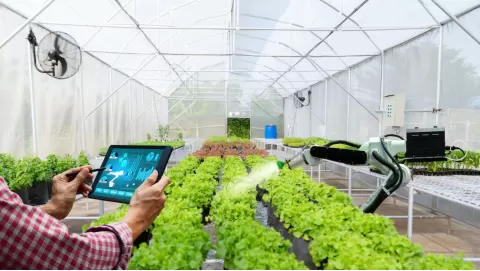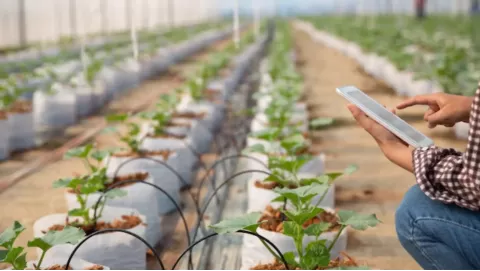
Maximizing Crop Performance with Advanced Nutrient Solutions
In today’s competitive agricultural and horticultural landscape, the difference in crop performance between average and sustainable levels comes from smart nutrient management. Plants, like anything living, need a specific balance of macro and micronutrients to flourish, and as growing environments change, so must our nutrient strategies. The days of “one-size-fits-all” feeding schedules are over. Modern cultivators, however, use science-based formulations, real-time data, and sophisticated delivery systems to increase yield, flavor, and resilience.
- What: Precision nutrient management strategies that enhance crop performance through specific formulations, delivery systems, and real-time data. Understanding macronutrients, micronutrients, and plant stage needs helps ensure the right nutrient is delivered at the right time.
- Ideal For: Farmers who seek higher yield, better taste, disease resistance, and sustainable agriculture through targeted nutrition programs.
- Key Players:
- Phive8 Distribution: Premium hydroponic products, lighting solutions, and advanced nutrient systems.
- Helena Agri-Enterprises: Custom fertility programs developed from decades of agronomic experience.
- Geoponics: Focused on nutrition for healthy soil and turf, emphasizing long-term soil wellness and crop health.
- Nutes Nutrients: Stage-specific nutrient formulas designed to support each phase of plant growth.
- Tip: Regularly review and adapt your nutrient program based on crop type, growth stage, and environment to boost yields and reduce waste.
Plant nutrition has become about innovation and precision, and growers need partners that will be a steady part of that advantage. Phive8, Helena Agri-Enterprises, Geoponics, and Nutes Nutrients are some of these companies. These brands drive the transformative empowerment of growers, enabling them to produce food smarter and more effectively, unlocking the genetic potential of their crops.

This article will discuss how collaborations with the right nutrient providers can take your growing strategy from strength to strength.
The Science Behind Plant Nutrition
Plant growth is governed by a few key factors, and understanding what those are is crucial for producing crops that are stronger and healthier. People aren’t feeding the plant, though, but recently they’re delivering the proper entities in the right aspect at the correct time. Soil-grown vegetables and other plants each depend on a balance of nutrients to thrive.
Essential Macronutrients and Micronutrients
Macronutrients — these are different components that plants need in large amounts to grow properly. Nitrogen (N) promotes the growth of leaves and chlorophyll, while phosphorus (P) promotes root systems and flowering. Potassium (K) toughness because it enhances resistance to diseases. These three alone are the basis of most nutrient formulas.
Secondary macro nutrients like calcium, magnesium, and sulfur provide important supporting roles. Each has its own function:
- Calcium helps to fortify the walls of cells.
- Magnesium plays a crucial role in photosynthesis.
- Sulfur aids plants in manufacturing proteins.
Micronutrients make up less than a third of the plate — but they’re just as vital. Also, zinc, copper, manganese, and iron all contribute to controlling enzyme activity, hormone production, and nutrient transfer within the plant. Any deficiency may have serious health consequences.
Nutrient Uptake and Plant Metabolism
Now that nutrients are available in the growing medium, plants depend on their roots to uptake them. But absorption doesn’t happen automatically — it requires a carefully calibrated environment.
Availability of nutrients is directly affected by pH levels. If the pH is too high or too low, roots are incapable of absorbing necessary elements, even when they are available. Most crops, including lettuce and strawberries, prefer slightly acidic pH levels between 5.5 and 6.5.
Water quality is also a big consideration. Excess salt, chlorine, or hard minerals can restrict nutrient absorption or create a buildup. That’s why many growers utilize filtered or reverse osmosis water systems, so they have greater consistency.
And finally, temperature drives metabolic activity. Warmer temperatures speed up nutrient uptake, but too much heat can damage roots. Balanced environmental control results in optimal nutrient uptake and utilization, allowing for healthy, vigorous growth at all stages.
Leveraging Distribution Networks to Access Top-Tier Nutrients
In contemporary agriculture, fertility, use efficiency, and access are three essential keywords. Growers have access to all the premium nutrients and cultivation supplies through networks of distribution.
Dependable access to quality inputs prevents disruptions and gives farmers the ability to plan better, resulting in robust harvests. Distributors who respond to grower needs connect supply to success.
The importance of distribution networks:
- Faster delivery of essential products
- Frequent inventory and restocks
- Care with excellent product knowledge
The most important, though, for a successful operation is the supply chain; efficient supply chains keep your operation humming along because plant growth is all about timing. The challenge of enhancing nutrient use efficiency for field crops involves a combination of conservation practices, site-specific approaches, and new technologies. Practices such as conservation tillage and variable rate application minimize nutrient losses and match the right nutrient source with crop requirements precisely. These practices, enabled by decision support systems, equip growers with information to make more informed decisions that improve yield without harming the environment. This helps growers to understand at a deeper level that they can better sustainably manage their inputs to improve yields.
Phive8: Your Grow Buddies for Success
Phive8 is more than a supplier — they’re growers’ besties. Phive8 is a leading supplier of hydroponic and other cultivation products, trusted by both professionals and hobbyists.
Inventory tailored to fit every grower, from soil to lights – you can find:
- Premium nutrients from brands such as Plagron Green Sensation and PK Apatite
- Advanced hydroponic systems for maximum efficiency
- Premium grow media and environmental control tools
But Phive8 is different; they prioritize reliability and near-instant shipping, and when their customers come first, it's a partnership, not a transaction.
These densitizers help cultivate flowering density, target certain growth cycles, and improve terpenes in plants with products like Plagron Green Sensation, PK Apatite, and Ruby Ful#$%. The Spring Green, Summer Shift, and Winter Frost blends keep the nutrient delivery in rhythm with the evolving growth cycles for customers interested in full seasonal care.
Precision Agriculture and Tailored Fertility Programs
How precise is precision agriculture? Plant nutrition and precision agriculture. With data-driven insights and tailored fertility planning, crops can be fed precisely the nutrients they require — no more, no less.
Bespoke fertility programs take into account soil conditions, crop type, climate, and timing. It allows for precise measurement, which minimizes waste and maximizes nutrient absorption, so the end product is healthier and yields are higher.
Some of the reasons to pursue personalized fertility are:
- Optimized nutrient uptake
- Lower input costs and smaller environmental footprint
- Higher yield and crop quality
It means that every acre matters and every nutrient stream.
Helena Agri-Enterprises: Customized Nutrient Programs
Helena Agri-Enterprises, founded on a legacy of generations of agricultural success, traces its roots back to the agricultural world. As the pioneer of precision nutrient programs, Helena’s location-specific solutions remain the industry standard.
Their approach includes:
- Fertilizer plans are designed specifically for the crop type, soil health, and climate
- Advanced delivery mechanisms for maximum bioavailability
Helena understands that no two farms, no two plants are alike. Its strategy is science-based, enabling cultivators to make data-informed decisions to optimize on-field performance.
Prioritizing Sustainable Soil and Turf Health
It all starts from the ground in when it comes to sustainability. Soil health is the bedrock of crops that can survive extreme weather events, stunning vistas and fruitful pastures.
Soil restoration and sustainable nutrient availability are critical to growers as providing resources to protect a vital natural resource allows for a higher-performing plant material. Everything from water stewardship to eco-friendly organic inputs to environment-safe soil conditioners helps bring sustainability into the everyday growing practice.
Sustainable soil strategies include:
- OMRI-listed and eco-friendly nutrient use
- Remediation of soil for damaged or depleted areas
- Water treatment solutions to enhance uptake and reduce runoff
Prioritizing soil health today sets the stage for tomorrow’s success.
Geoponics: Feeding the Soil to Feed the Plant
Healthy soil means healthy crops; this is the first step. That underpins the philosophy behind Geoponics, a company disrupting the way people think of plant nutrition and land management. Their solution suite includes everything from organic landscape colorants and soil surfactants to soil remediation and OMRI-listed fertility products.
What if you’re battling compacted soil, poor water retention, or even nutrient lockout? Geoponics provides game-changing tools to help you combat these:
- Agriox enhances soil oxygen for more powerful root systems
- Detox lowers soil salinity, providing a better nutrient exchange environment
- Sustainable fertilizers and foliar applications build soil properties and increase yield
From the grower who demands more than a quick crop, who wants sustained, long-term land performance, Geoponics delivers.
Feeding with Precision Across Every Growth Stage
Your feeding regimen must evolve with your plants. Nutritional needs swing wildly between early veg and peak bloom, and maintaining specialized formulas at each stage makes sure little is left to chance.
A growth-stage-driven feeding plan provides the plant with exactly what it needs, and exactly when it needs it. The method encourages solid growth, reduces stress, and improves the overall quality of the end-of-harvest.
This is why targeting based on the stage of growth works:
- Specific nutrients that stimulate early vegetative growth
- Enhances flowering and fruiting during the flowering period
- Support of plant immunity and prevention of deficiencies
Better timing will lead to more numbers when it matters most and a more efficient harvest.
Nutes Nutrients: Targeted Formulas for Every Growth Stage
Nutes Nutrients puts precision at the top of the tree. That's why they're focused on allowing their timeline to cater to specific points of plant life to give them what they want when they need it.
Top formulas include:
- Veg Builder for early-stage growth, lush vegetation
- PK Punisher to increase bud production
- Cal-Magnum and Silica Trich Rush for structure and terpene production
Catering to a market demanding purity and performance, Nutes also provides 99.98% Isopropyl Alcohol to keep the growing environment clean and safe.
Building a Crop Nutrition Strategy for Maximum Yield
It’s not by accident that you get a great harvest—it starts with a good nutrition plan. Knowing your crop needs and managing inputs throughout the life cycle gets the attention at every stage required.
Understanding Your Crop’s Lifecycle Needs
Each crop growth stage has development-specific nutritional requirements. Seedlings require gentle nurturing, vegetative plants desire nitrogen, and flowering crops excel with phosphorus and potassium.
Creating a stage-specific feeding schedule helps:
- Optimize energy consumption in every growth phase
- Avoid overfertilizing, or nutrient lockout
- Support vigorous growth and big yields
Whether you’re growing under LEDs indoors, in a greenhouse, or out in the field, following an environment-matching feeding plan ensures that you make efficient use of nutrients.
Monitoring and Adjusting Nutrient Delivery
No good plan is without adjustment. Monitoring pH, electrical conductivity (EC), and runoff periodically serves to examine plant nutrient uptake.
Stay in control by:
- Regularly test your irrigation water and runoff
- Watching for signs of deficiency or toxicity
- Making tweaks to your algorithms according to actual performance
As you read the plant and the data, you can escape before little problems turn into big ones.
Integrating Environmental and Nutrient Control
Environmental conditions deeply affect nutrient uptake. As light intensity, temperature, or CO₂ levels change, so does the metabolism of the plant.
Creating harmony between nutrition and the growing environment is important for stimulating uptake. This includes:
- Matching feeding intensity to light output
- Controlling the temperature to preserve root health
- Supplementing CO₂ during peak photosynthesis
Tech and tools enable smart growers to align these factors, so feeding and growing can work hand in hand for optimal results.

Nourishing crops is more than just about producing more — it’s also about producing better. Proper nutrient management will reduce their costs, use, and damage to the environment.
Reducing Waste and Environmental Impact
Excess fertilizer and runoff can pollute waterways and damage soil organic matter. This is why sustainable growing is all about precision.
Key practices include:
- Using slow-release or water-soluble formulas
- Apply nutrients through foliar sprays
- Establishing drip irrigation or fertigation systems to increase accuracy
Such practices decrease waste, conserve water, and lessen the possibility of adverse environmental impact.
FAQs
Q1: How do I choose the right nutrient program for my crop? Consider your growing environment, the type of plants you’ll be growing, and your goal for how you want them to grow. And soil tests and/or water analysis, and reputable companies like Helena Agri-Enterprises or Nutes Nutrients for customized plans based on real data and experience.
Q2: What’s the difference between macronutrients and micronutrients? The macronutrients nitrogen, phosphorus, and potassium are required in large quantities and support important functions such as growth, flowering, and root development. Iron, manganese, and zinc are examples of micronutrients that plants need in smaller amounts, but they are essential for enzyme function, hormone balance, and overall plant health.
Q3: Can nutrient delivery methods affect plant performance? Absolutely. Whether through drip irrigation, fertigatio,n or foliar sprays, how you deliver nutrients to plants determines how effectively they absorb those nutrients. At the right time, they must align with environmental conditions such as water quality, pH, and temperature for optimum uptake.
Conclusion
Nutritional management is no longer an afterthought in modern cultivation, but a strategic cornerstone behind success. Whether you're in the business of growing leafy greens, ornamental turf, or high-value crops, the right response to provide the perfect nutrition at the perfect time can be the difference between success and failure for your harvest.
As highlighted throughout this article, the road to optimum crop performance is paved with precision, targeted, and sustainable solutions. By partnering with such distributors as Phive8 Distribution, Helena Agri-Enterprises, Geoponics, and Nutes Nutrients, growers don't just get access to quality products, but expert support, innovative tools, and the confidence to feed smarter.
Advanced nutrient strategies take potency to performance, from optimizing soil fertility and minimizing environmental impact to improving your terpene levels and yield. So, however you’re managing one grow room or a whole farm, just remember: you eat what you sow.
Disclaimer: This material is for informational purposes only and should not be relied on for legal, medical, financial, or other professional advice.
Sources:
ResearchGate - Sustainable Nutrient Management Strategies for Increased Crop Productivity and Soil Health
Science Direct - Plant Nutrition


























